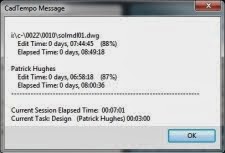Hello and thanks for coming by for a visit.
I hope I can keep this interesting for you as I touch on a subject that I find is not often discussed or covered in my web travels, time - relating to the creation of drawings and engineering documents. I've developed a time logging solution called CadTempo http://www.cadtempo.com to assist in recording the amount of time I spend in performing my job.
Time is frequently referred to as the "fourth dimension" and this concept is certainly valid. In this sense of course the reference pertains to the movement of a three dimesional object as it travels through space. This blog, however, will focus on time as a measurement of work production by users of CAD software such as AutoCAD, Inventor, Revit and other popular 2d and 3d drafting products. I believe this is an important subject, as "time is money" and to understand where your money is being spent you need to know where your time is being spent.
My interest in this subject is framed by my need as a small business owner to have a firm understanding of the cost associated with the job functions performed in my daily activities. I started my business, Engineered Design Solutions http://www.engds.com , in 1991 after developing a machine to manufacture drinking straws based on an idea that I had. My previous employer had recently sent me to CAD training and during the evening hours I designed my machine and created the details for its build.
During my employment I had kept detailed records of the time that was required to complete the design projects that were assigned to me. For the most part, this was time that I had monitored while manually drafting with a drafting board and Vemco drafting machine. After a while I came to establish a consistent measurement of work product. This was manually recorded on paper that documented the number of manufactured details that were designed for the project as well as the number of commercial items that were a part of the final design. In addition to recording the number of components that made up the design I segregated the number of hours involved in design and layout, detailing and checking.
After starting my company, armed with this data as a benchmark I was able to compare CAD drafting to my manual methods and determine improvements that I made to my work environment by means of customization of AutoCAD via AutoLISP programs and modifications to the AutoCAD user interface. In future articles I will share the data I had gathered.
Monday, June 15, 2009
Subscribe to:
Posts (Atom)



